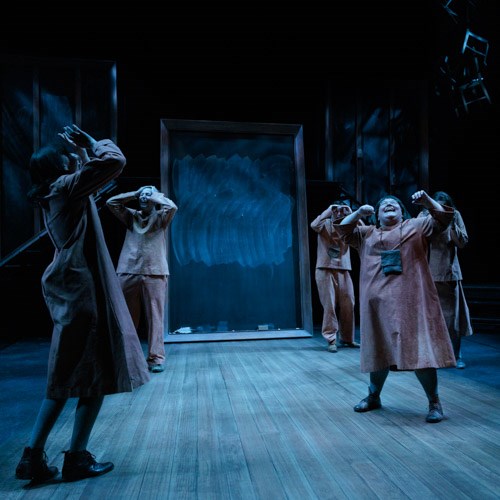If the goal of Jani Lauzon and Kaitlyn Riordan, co-playwrights of the gripping 1939, was to put recognizable names, faces and emotions into a tragic news story gripping Canada and the world for the past two years, their objective is a stunning success.
Over that short period of time horrific news stories have reported numerous gruesome discoveries of the remains of countless unnamed individuals – largely Indigenous children – in unmarked graves at the sites of former residential schools across Canada.
Now, after five years of exhaustive research and co-writing, Lauzon and Riordan have added a personal touch to an unfolding slice of history, transforming newsprint and daily sound bytes into a powerful theatrical vehicle resonating with individuals’ drama, loss and reconciliation.
Author and advocate Bev Sellars formerly served as councillor and chief of Xatśūll (Soda Creek) First Nation in British Columbia. Her memoir, They Called Me Number One, about her experiences in the residential institution St. Joseph’s Mission, formed a key part of research for 1939.
Opening night, the play took on a further feeling of emotional poignancy with an onstage performance of a captivating song by the Traditional Women Singers from Oneida – Janice Ninham, Danielle Hill and Amanda Doxtator – about love, a community united without focusing on racial differences
The story focuses on a fictional church-run school in Northern Ontario in 1939 where a hockey-loving Anglican priest and comically flatulent Father Callum Williams prepares for an upcoming visit by King George VI and Queen Elizabeth.
Played in wonderfully frenetic fashion by Mike Shara who, though he has no idea of who William Shakespeare is, has nonetheless agreed the regal pair will be entertained by the student body’s version of All’s Well That Ends Well.
It is to be directed in a very correct Elizabethan way by the prim and proper teacher Miss Ap Dafydd (brought to life by the magical Sarah Dodd), a woman who appears to be theatrically guided by three simple words “big round vowels”.
What neither the priest nor teacher count on is that the student body will see their own life experiences mirrored in the Bard’s work, seizing the opportunity to make a classic piece of English theatre their very own.
With their own unique brand of humour and a subtlety sly approach, alongside a newspaper article penned by Jacklyn Francis’s flashy local scribe appropriately named Madge Macbeth, Elizabethan iambic pentameter appears on the road to become a more newsworthy “Indian Shakespeare”, much to the initial chagrin of school authorities.
Rich with textual and visual symbolism, like blackboards being continuously wiped clean of inner thoughts, personal symbols and student letters never to reach parents at home, the soul of the production is the proud resilience of the five young students brought together under unusual circumstances.
Wahsonti:io Kirby is the eloquent, spiritually motivated by her grandfather Mohawk girl Evelyne Rice selected for the role of Helena but from a perspective that will fight the generic Indian concept and never bow to the school’s prejudiced goal of “killing the Indian in us.”
As siblings are normally forbidden to mix at the school, Ojibwe brother and sister Joseph and Beth, the latter the only student with any knowledge of Shakespeare (portrayed with strength and compassion by Richard Comeau and Tara Sky) find themselves coping with new surroundings, dealing with their own conflicts, destinies and his goal of leaving “this hell-hole”.
John Wamsley serves up a moving performance as the Algonquin Métis Jean Delorme, more often referred to as a half-breed. While there are “no pucks in Shakespeare”, he excels at the local hockey rink, leading his team to a championship yet still finding the greatest opposition both on and off the ice is unchecked discrimination without reason.
In her unforgettable and truly heart-wrenching portrayal of the often brutally beaten Cree student Susan Blackbird, Kathleen MacLean is the only onstage visual sign of this abuse, a sad reminder of the residential school system’s intent of “cultural genocide” as concluded by the Truth and Reconciliation Commission of Canada (TRC).
With her double duties as director of this timely production, co-playwright Lauzon handles the task with even-paced precision, giving 1939 an audience-friendly evening digesting vital historic information balanced with humour and drama in an accessible and compassionate manner.
Buoyed by a strong artistic company, the play is a five-star effort relying on an excellent, almost minimalist set by designer Joanna Yu; unique original music and sound from Wayne Kelso; subtle lighting by Louise Guinard; with producer David Auster and numerous individuals responsible for translation, spiritual and traditional, cultural research, costuming and dramaturge.
As for the title 1939, consider the following Canadian Encyclopedia entry written by R. Scott Sheffield:
“In 1939, Canada found itself at war for the second time in a generation. As in the First World War (1914-18), thousands of Indigenous soldiers and nurses volunteered for the war effort at home and abroad, serving with distinction in the Canadian army, navy, and air force.
“At least 4,250 First Nations soldiers enlisted in the Canadian military in the Second World War, with thousands more Metis, Inuit, and non-Status Indian soldiers serving without official recognition of their Indigenous identity.
“Unlike during the First World War, Canadians acknowledged Indigenous participation during the Second World War As the country looked to create a new order in the aftermath of the war, many Canadians suddenly looked at their country’s treatment of Indigenous peoples and did not like what they saw.”
Garnering an instantaneous standing ovation from the opening night audience, 1939 continues at the Studio Theatre until October 29.



